Lobelia Is An Astonishingly Diverse Genus – Here Are 14 Hand-Picked Varieties

PERENNIALS > LOBELIA > VARIETIES

Elizabeth is a Permaculture Garden Designer, Sustainability Consultant and Professional Writer, working as an advocate for positive change. She graduated from the University of St. Andrews with an MA in English and Philosophy and obtained a Diploma in Applied Permaculture Design from the Permaculture Association.
Reviewed By DAN ORI

Dan has over 27 years’ under his belt caring for plants and gardens. Working as a Horticultural Instructor and Consultant, he draws on a diverse range of experience that includes working as a Head Gardener, Tree Surgeon, Garden Centre Trouble Shooter, and writer of academic papers. Dan has a Level 3 Diploma in Horticulture and is currently a candidate for the RHS’s most prestigious award – The Master of Horticulture.
IN THIS GUIDE
- 1) L. x speciosa
- 2) L. cardinalis
- 3) L. erinus
- 4) L. ‘Laguna Compact Blue With Eye’
- 5) L. erinus ‘Crystal Palace’
- 6) L. ‘Laguna White’
- 7) L. × speciosa ‘Monet Moment’
- 8) L. × speciosa ‘Hadspen Purple’
- 9) L. cardinalis ‘Black Truffle’
- 10) L. siphilitica
- 11) L. tupa
- 12) L. laxiflora
- 13) L. dortmanna
- 14) L. urens
- References
LOBELIA GUIDES
Container Growing
Sowing
Varieties
Lobelia is an astonishingly diverse genus of herbaceous flowering plants, with between 420-440 species and many more cultivars.1Foster, A. (n.d.). Lobelia species. Oxford University Plants. Retrieved March 21, 2023, from https://herbaria.plants.ox.ac.uk/bol/plants400/Profiles/kl/Lobelia
These include annuals, biennials, tender perennials, and hardy perennials, and their habits are just as diverse and include upright, bushy, clump-forming and trailing.
As for the flowers, they occur in solitary form, in panicles, or in racemes.
It is hardly possible to do justice in one article to the varieties of a genus that is both as large and as varied as lobelia.
Below we list a few essential species and outline some popular cultivars:
1) L. x speciosa
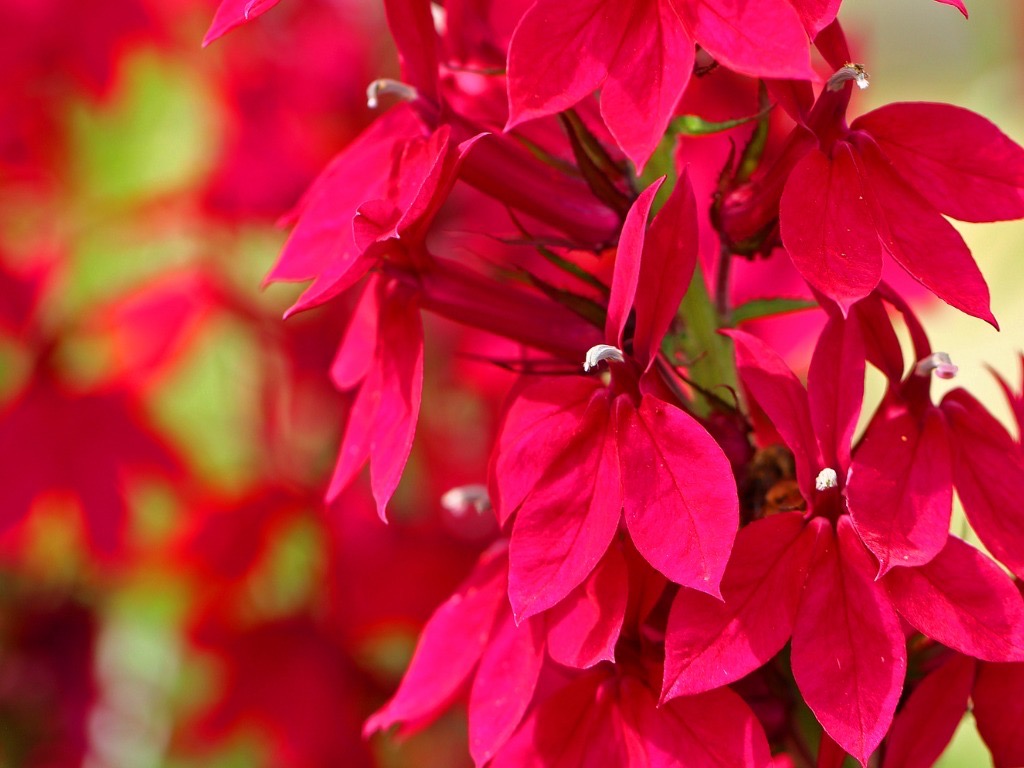
- COMMON NAME(S): Lobelia × speciosa
- HARDINESS RATING: H5
- FOLIAGE: Bronze, red and green
- FLOWERS: Blue, pink, purple and red
- FLOWERING SEASON(S): Summer / Autumn
A popular group of lobelia varieties commonly grown in the UK is a group of hybrids derived from L. cardinalis and L. siphilitica.
L. x speciosa are perennial plants but are also often grown as annuals in UK gardens, as most are only borderline hardy and will only typically make it through the winter in milder regions.
These are often grown as summer bedding plants and are also commonly grown in containers.
2) L. cardinalis
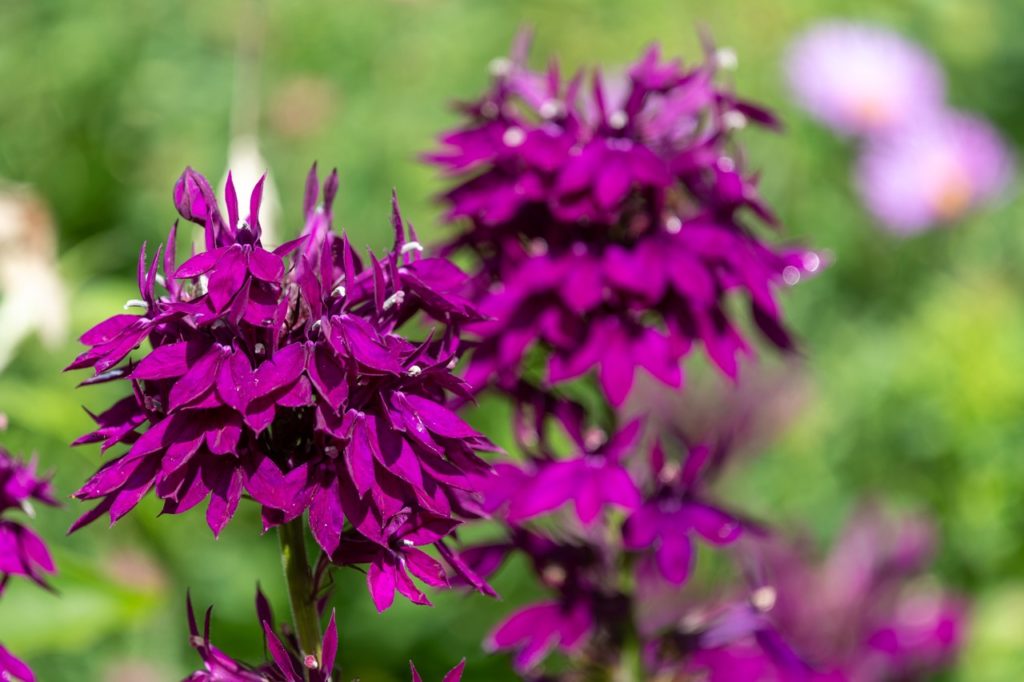
- COMMON NAME(S): Cardinal flower
- HARDINESS RATING: H3
- FOLIAGE: Green
- FLOWERS: Purple and red
- FLOWERING SEASON(S): Summer / Autumn
The cardinal flower is a species that is both very hardy and also heat tolerant.
It is a very tall species with an upright habit and bears big flowers on spikes that are a deep, intense reddy-purple hue, producing blooms well into autumn.
Though not native to the UK, and usually fairly short-lived, it can be planted anywhere where soil remains reliably moist or boggy all year round.
“Give your garden an exotic feel by planting Lobelia cardinalis ‘Queen Victoria’,” says Master Horticulturist Dan Ori.
“I love the black-purple leaves crowned with vibrant red flowers. For a totally tropical look, plant L. ‘Queen Victoria’ with red, green and purple varieties of Canna and Imperata ‘Red Baron’ (Japanese blood grass).”
3) L. erinus

- COMMON NAME(S): Trailing lobelia
- HARDINESS RATING: H2
- FOLIAGE: Green
- FLOWERS: Blue and purple
- FLOWERING SEASON(S): Spring / Summer / Autumn
Probably the best-known and most planted Lobelia for UK gardeners is the trailing lobelia – L. erinus.
This flowering plant grown as a summer annual in UK gardens is native to southern Africa.
In the wild, the flowers are blue to violet, but many different cultivars have developed with flowers in many different hues, often with white eyes at the centre.
These plants are popular with gardeners for use as bed edging, for the front of borders, and, especially, for use in hanging baskets and pots.
They are typically relatively compact plants, with bushy or trailing habits of growth.
4) L. ‘Laguna Compact Blue With Eye’
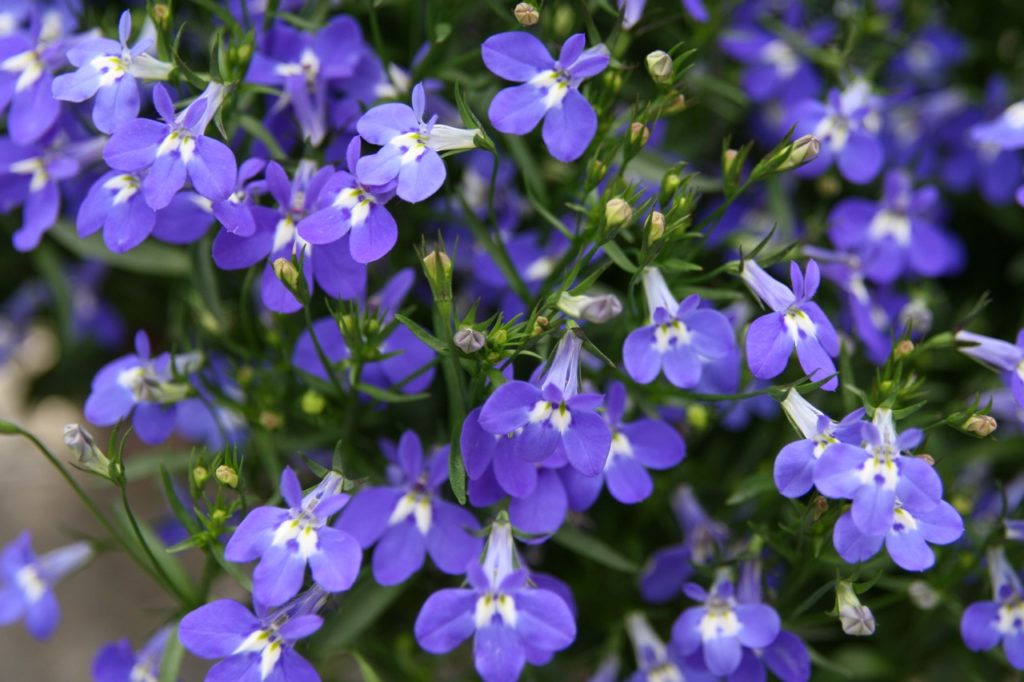
- COMMON NAME(S): Lobelia [Laguna Compact Blue With Eye]
- HARDINESS RATING: H2
- FOLIAGE: Green
- FLOWERS: Blue
- FLOWERING SEASON(S): Summer / Autumn
This variety grows to 25-30cm with a similar spread.
It has a semi-upright, bushy habit and is very floriferous, flowering from summer to mid-autumn.
It bears lilac-blue flowers with a prominent white eye and is ideally suited for borders and also for containers.
5) L. erinus ‘Crystal Palace’
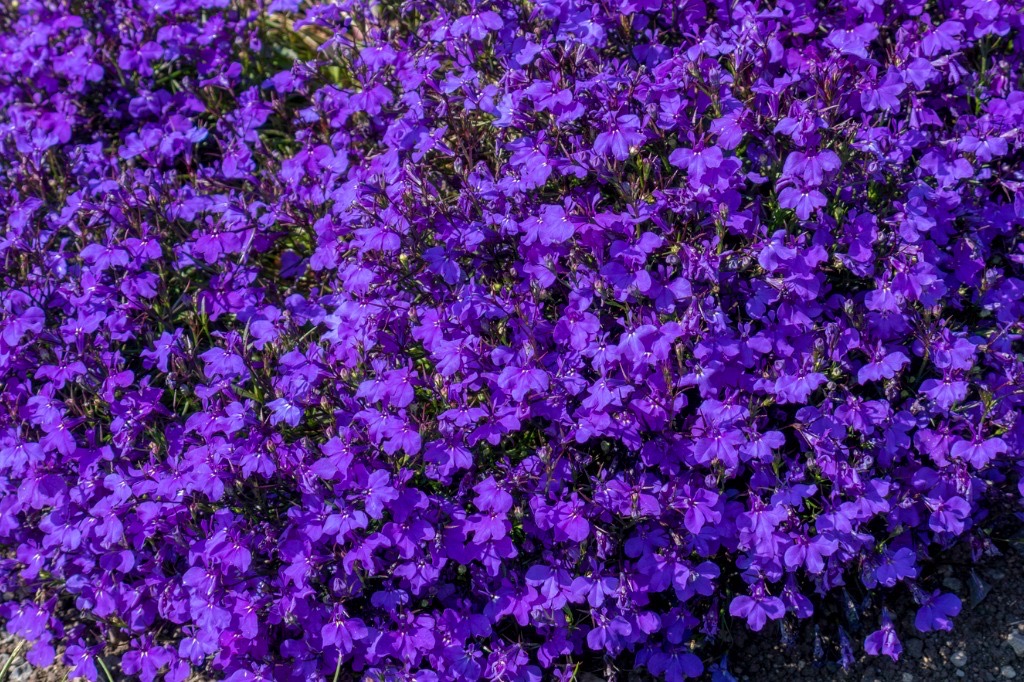
- COMMON NAME(S): Trailing lobelia ‘Crystal Palace’
- HARDINESS RATING: H2
- FOLIAGE: Bronze and green
- FLOWERS: Blue and purple
- FLOWERING SEASON(S): Summer / Autumn
‘Crystal Palace’ is a dwarf variety that reaches only 10cm in height and has a bushy habit.
This popular variety is a tender annual.
Both the foliage and flowers are striking, as the leaves are of a deep bronze green shade and the blooms are of a deep, intense hue of blue, crossing over into purple.
This variety has received the RHS Award of Garden Merit.
6) L. ‘Laguna White’
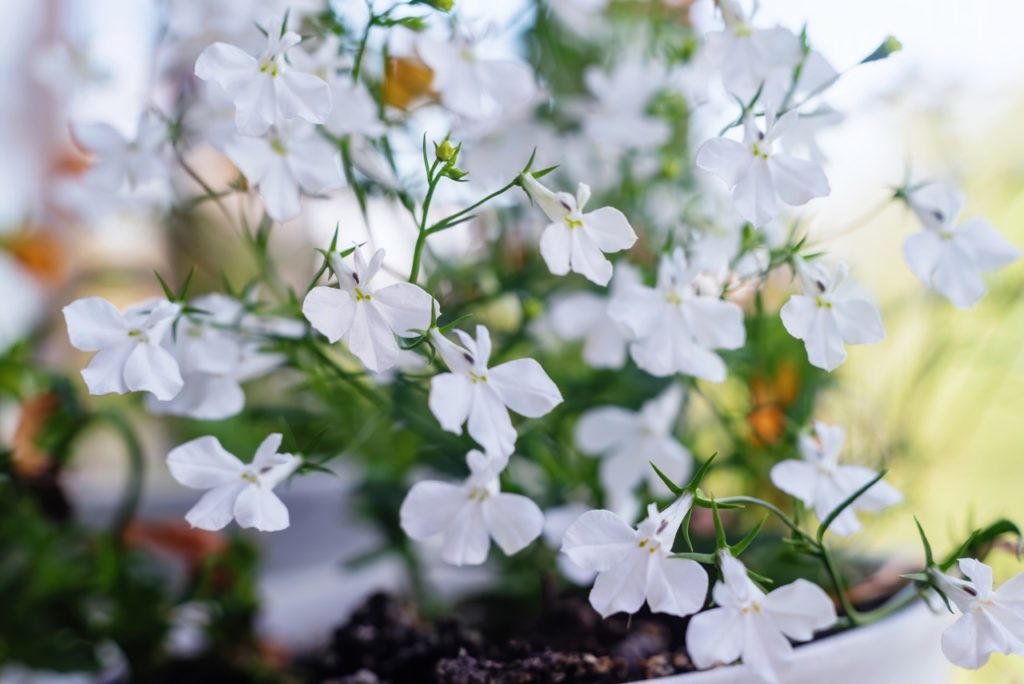
- COMMON NAME(S): Lobelia [laguna white]
- HARDINESS RATING: H2
- FOLIAGE: Green
- FLOWERS: White
- FLOWERING SEASON(S): Spring / Summer / Autumn
‘Laguna White’ is a classic cascading lobelia variety that you may see tumbling out of a basket.
It has a trailing habit and attains a height of 25-30cm with a spread twice as big.
Unusually for lobelias, this one is heat tolerant, at least more so than most.
It produces masses of pure white flowers.
7) L. × speciosa ‘Monet Moment’
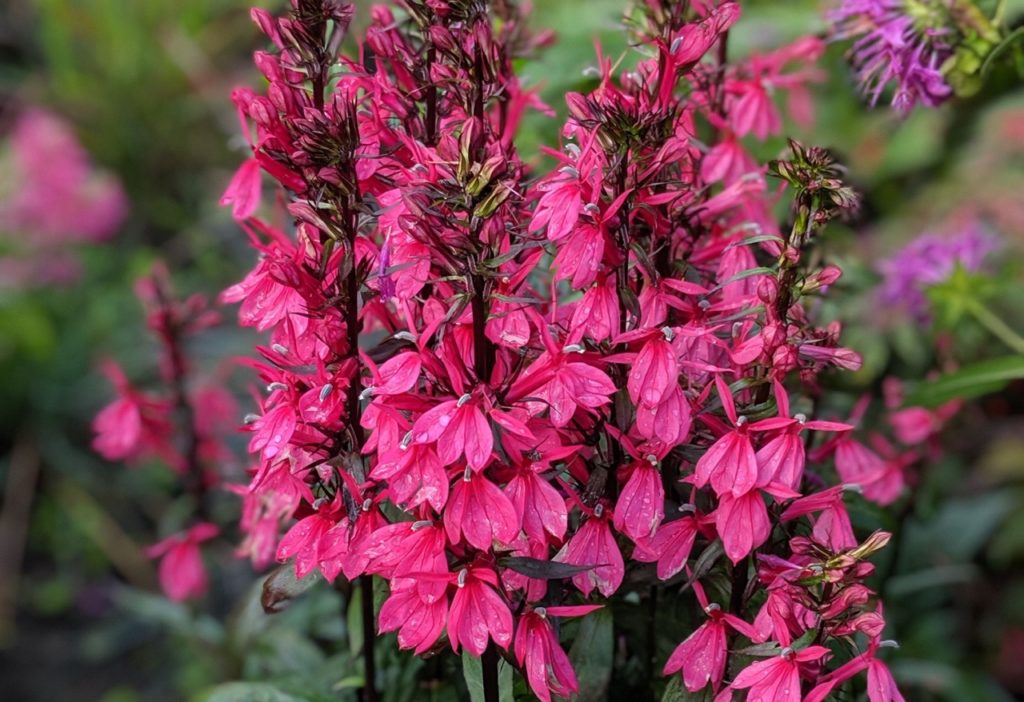
- COMMON NAME(S): Lobelia ‘Monet Moment’
- HARDINESS RATING: H5
- FOLIAGE: Green
- FLOWERS: Pink
- FLOWERING SEASON(S): Summer / Autumn
‘Monet Moment’ is a tall variety at 80cm and has a clump-forming, upright habit.
It has a relatively short flowering season that starts in late summer.
This somewhat under-rated variety has a robust yet beautiful appearance as spikes hold up spires of brilliant magenta-pink blooms.
8) L. × speciosa ‘Hadspen Purple’
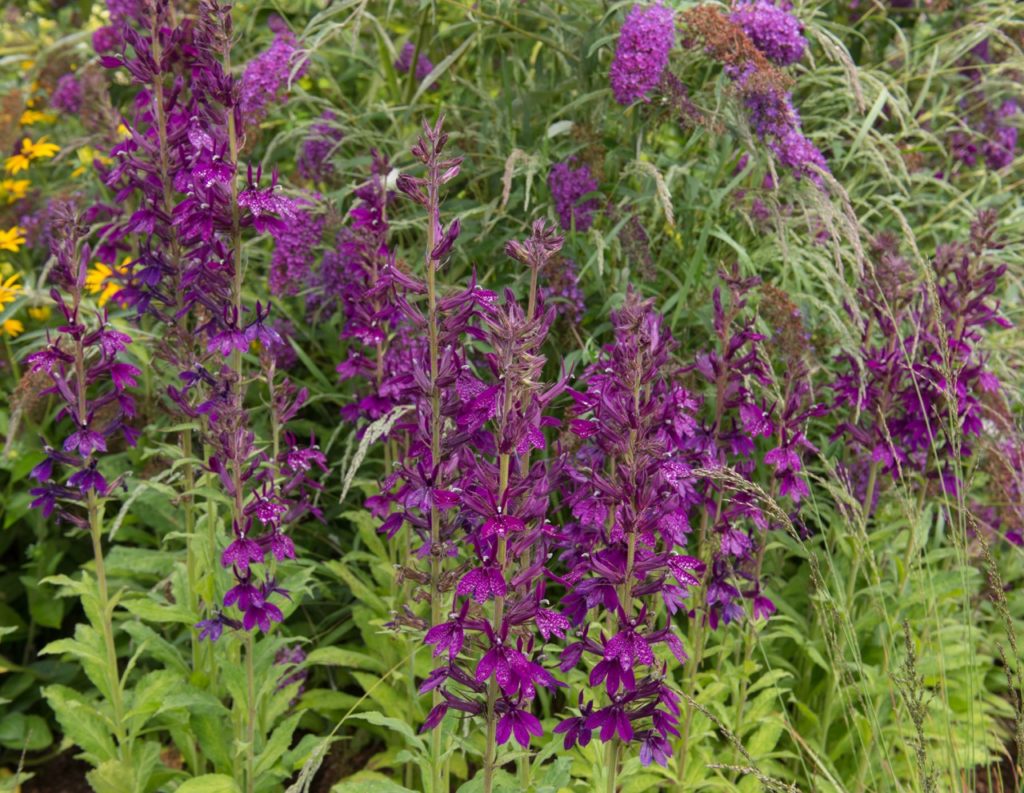
- COMMON NAME(S): Lobelia ‘Hadspen Purple’
- HARDINESS RATING: H5
- FOLIAGE: Green and purple
- FLOWERS: Purple
- FLOWERING SEASON(S): Summer / Autumn
‘Hadspen Purple’ grows to 50-60cm and has an upright habit and its attributes combine to make it very suitable for different garden needs.
The alternate leaves are of a rich green shade and look particularly neat on this variety.
The spikes bear racemes of brilliant purple-to-violet flowers.
It is one of the most popular varieties and is easy to find.
9) L. cardinalis ‘Black Truffle’
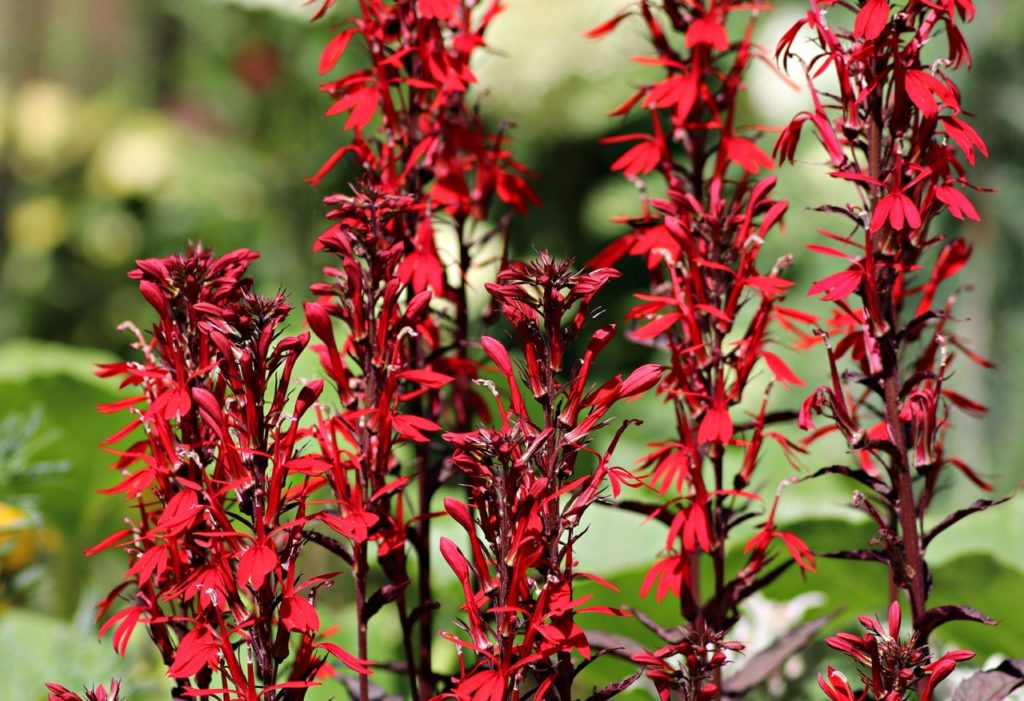
- COMMON NAME(S): Lobelia ‘Black Truffle’
- HARDINESS RATING: H3
- FOLIAGE: Bronze and brown
- FLOWERS: Red
- FLOWERING SEASON(S): Summer / Autumn
This variety inherits its flowers and habit from the parent species but the foliage provides a fresh twist.
As leaves sprout and form they are nearly black, maturing into a deep, rich chocolate-maroon shade with the lamina exhibiting a distinct sheen.
10) L. siphilitica
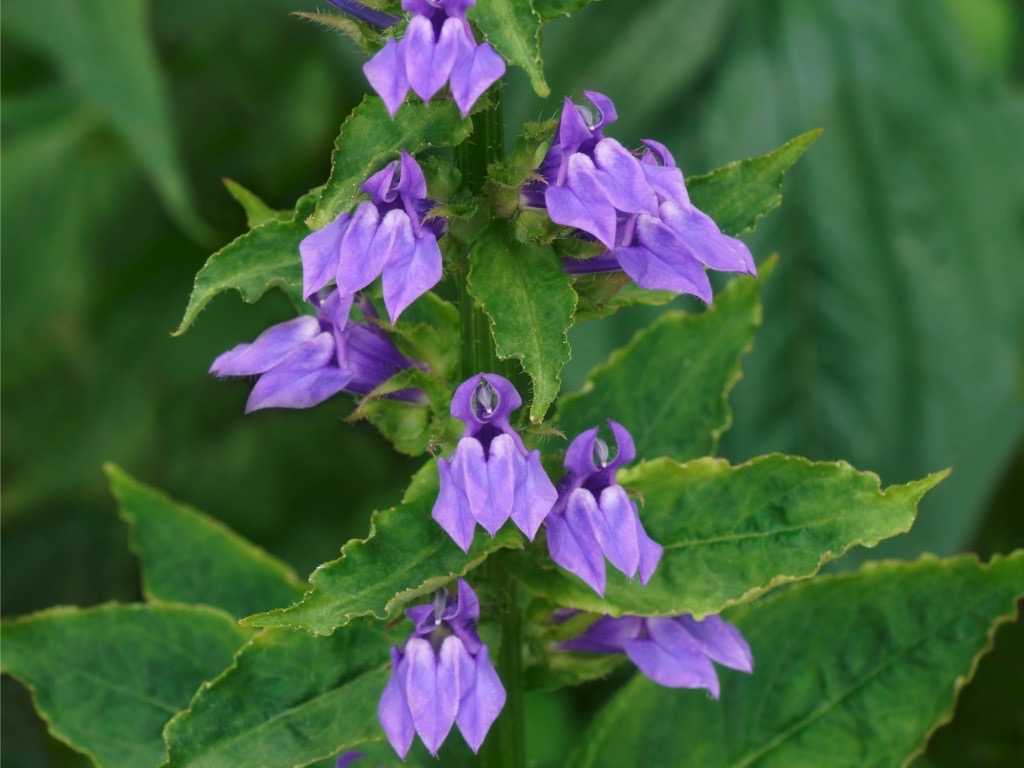
- COMMON NAME(S): Blue cardinal flower
- HARDINESS RATING: H5
- FOLIAGE: Green
- FLOWERS: Purple and blue
- FLOWERING SEASON(S): Summer / Autumn
Sometimes known as the blue cardinal flower, this is another perennial lobelia that blooms with blue or purple flowers between August and October and tends to last for a few years.
This variety also thrives in moist or damp conditions.
11) L. tupa
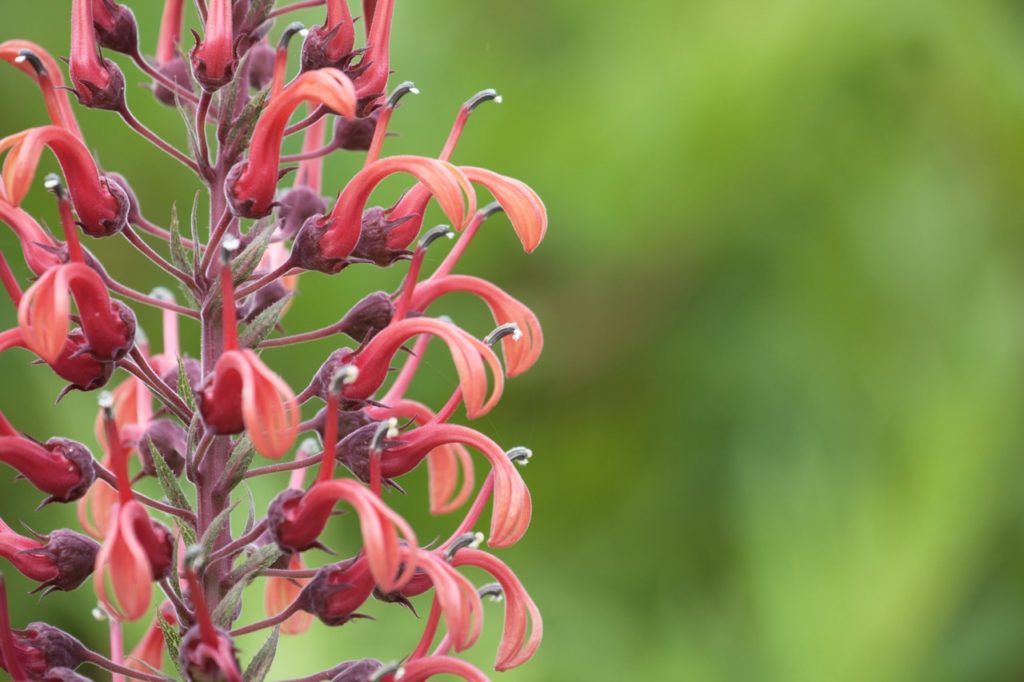
- COMMON NAME(S): Devil’s tabacco
- HARDINESS RATING: H4
- FOLIAGE: Green, grey and silver
- FLOWERS: Red
- FLOWERING SEASON(S): Summer / Autumn
While the options above are the most common options for UK gardeners, there are many other Lobelia varieties to consider.
One interesting option, for example, is L. tupa, also known as ‘Devil’s tobacco’.
This is an evergreen perennial and has an H4 hardiness rating.
It grows up to 2m in height and has narrow, hairy green leaves and terminal racemes of tubular, red flowers that are 6cm long.
Grow this in full sun, in a sheltered spot.
Unlike most lobelias, it also does best in well-drained soil.
12) L. laxiflora
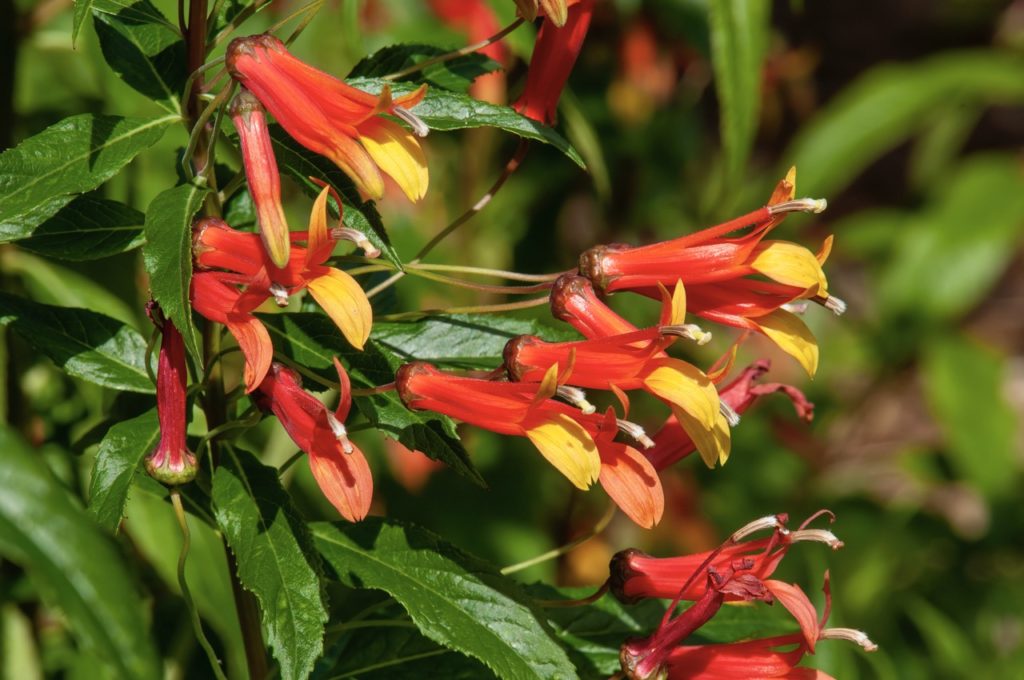
- COMMON NAME(S): Sierra Madre lobelia / Mexican lobelia
- HARDINESS RATING: H3
- FOLIAGE: Green
- FLOWERS: Yellow and red
- FLOWERING SEASON(S): Spring / Summer
Though known to reach heights of 3m, L. laxiflora commonly grows to around 1.5m or so.
The flowers are red and yellow in colour and have a hardiness rating of H3.
13) L. dortmanna
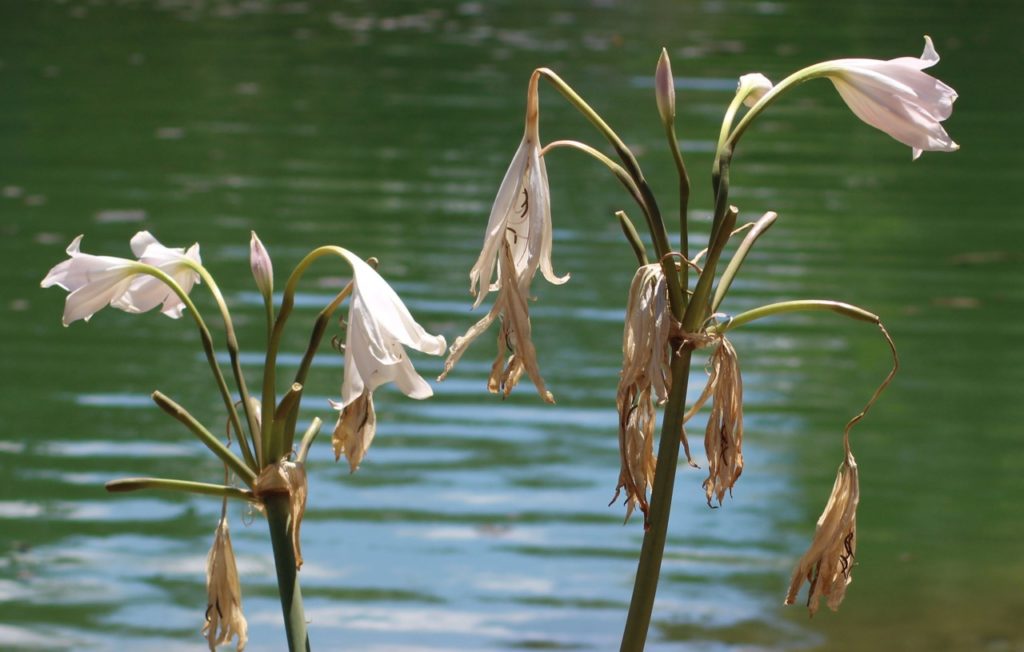
- COMMON NAME(S): Water lobelia
- HARDINESS RATING: H5
- FOLIAGE: Green
- FLOWERS: White
- FLOWERING SEASON(S): Summer / Autumn
This lobelia is different to the others on this list because it is not a lobelia that you might grow in your beds, borders or containers, but rather one that might be grown in a garden pond or on its boggy fringes in clay soil.
It naturally grows in or on the fringes of lakes and tarns with acid water and is native to cool temperate regions of northern Europe, including portions of the British Isles, and northern North America, especially in peaty and mountainous areas in Europe.2Lobelia dortmanna – Water Lobelia. (n.d.). First Nature. Retrieved March 21, 2023, from https://www.first-nature.com/flowers/lobelia-dortmanna.php
It is an aquatic herbaceous perennial plant with white flowers held on an erect raceme held above the surface of the water.
The plant is said to have the unusual ability to remove carbon dioxide from the rooting zone rather than from the atmosphere.3Lobelia dortmanna: Water Lobelia. (n.d.). NBN Atlas. Retrieved March 21, 2023, from https://species.nbnatlas.org/species/NBNSYS0000004299
14) L. urens
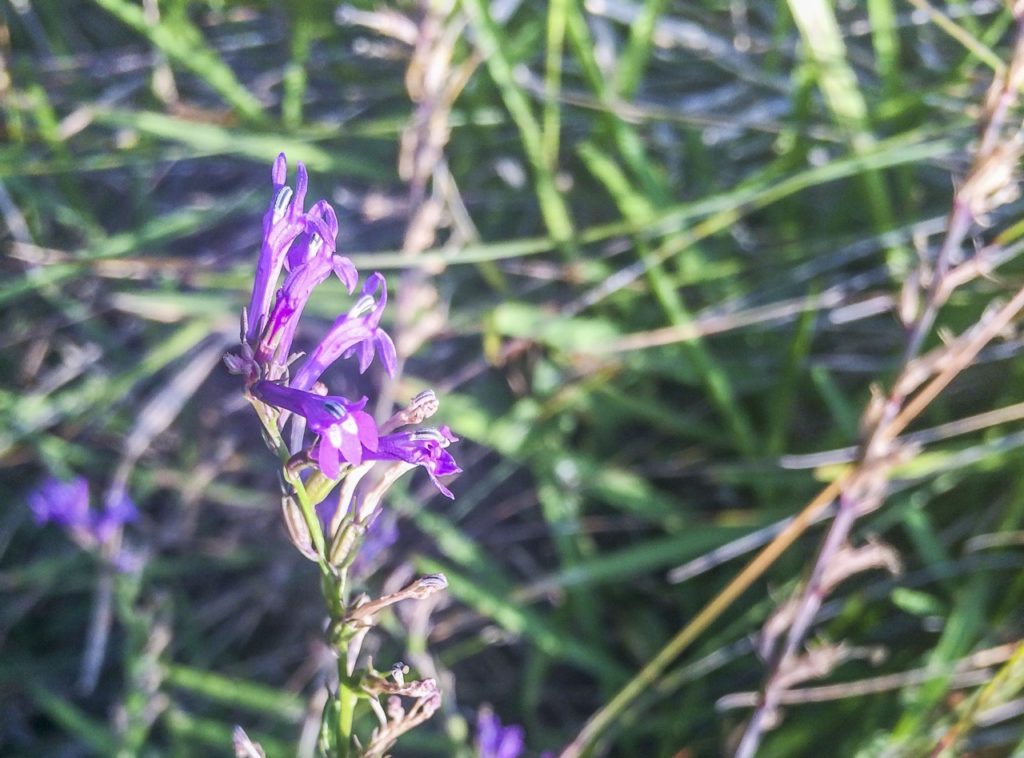
- COMMON NAME(S): Acrid lobelia / health lobelia
- HARDINESS RATING: H5
- FOLIAGE: Green
- FLOWERS: Blue and purple
- FLOWERING SEASON(S): Spring / Summer
Heath lobelia is rare in Britain but is found in isolated lowland areas of the South and South West of England.
It is a plant of grassy health and rough pastures and typically thrives on relatively infertile and acidic soils.
This perennial grows around 60cm tall, and has blue-purple flowers in late summer and early autumn.
The plant needs bare soil patches for seeds to germinate and will do best where the soil is relatively moist.
If you live in the south or south-west and want to establish an area of native meadows then this could be a good flower to consider for your meadow or grazing grassland mix.
References
- 1Foster, A. (n.d.). Lobelia species. Oxford University Plants. Retrieved March 21, 2023, from https://herbaria.plants.ox.ac.uk/bol/plants400/Profiles/kl/Lobelia
- 2Lobelia dortmanna – Water Lobelia. (n.d.). First Nature. Retrieved March 21, 2023, from https://www.first-nature.com/flowers/lobelia-dortmanna.php
- 3Lobelia dortmanna: Water Lobelia. (n.d.). NBN Atlas. Retrieved March 21, 2023, from https://species.nbnatlas.org/species/NBNSYS0000004299
